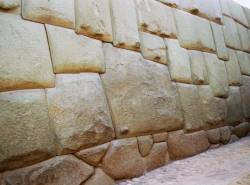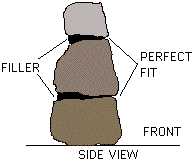
In a visit to Peru in 1999, I was intrigued by the Incas' amazing ability to built walls of perfectly matches stones. This picture shows Cuzco's famous 12-sided stone (center). The stones in this wall fit so perfectly, that you couldn't place a coin between them.

The Incas' art is lost, and many scientists (and amateurs) have tried to explain how the stones were transported, cut, fitted, and lifted. Theories range from the plausible to the far-fetched (giant solar mirrors, or even demons and UFOs!).
Now we think we understand how the massive stones were transported (on rolling logs).
We think we know that they were cut in the approximate shape with expanding wood.
We also think we understand how they were lifted (note the protrusions at the bottom of the stones in the picture - presumably, the workers lifted the stones with logs pressed against those protrusions).
And we have found the tools that the Incas used to carve the stones (hard stone tools - the Incas had no iron tools).
But we're still unsure of how the Incas fit the stones so perfectly.
Did they do it:
The only tools that we have found are stone cutting tools and lead weights.
|
Note that the perfect fit is only on the front surface: the stones are slightly wedge shaped, meaning that their cross sections are smaller inside the wall that they are on the outer surface. The internal space between rocks is taken by filler. |
 |
During that visit in 1999, I came-up with a theory on how the Incas could have easily cut the stones to shape while still on the ground, using only the tools that have been found. This technique is very simple, and seems to be quite doable. It lets the workers cut a stone in the shape of the opening in the wall in one try, so the stone has to be lifted only once.
Other than the tools that the archaeologists have found, this technique requires sticks and unfired clay, which I would assume would not have lasted the 500+ years since the last wall was built.
The workers would:
|
The wall is ready for a new stone. |
 |
|
Get a flat stone that is larger than the hole. Place it with its large face up. Carve that face to make it very flat and horizontal. |
 |
|
Prepare a frame of sticks inside the hole to be filled. (We are only concerned with the sides of the hole that are adjacent to other stones already in place.) |
 |
|
Add clay to the frame to make a form that fits perfectly to the hole. |
 |
|
Take out the form. |
 |
|
Rotate the form horizontally. |
|
|
Place the form on the stone to be cut, making sure it's horizontal. Trace the frame onto the stone to get a rough shape of the cut. |
 |
|
First cut the stone to the rough shape. Then, using a plum bob, carve it further to achieve a perfect match between the form and the stone edges. (Note that the stones have a slight wedge shape: the perfect match between stones is only on the perimeter of the outer face; therefore, the workers had to match only the top surface perimeter to the form.) |
 |
|
Move the stone to the wall. |
 |
|
Turn the stone upright |
 |
|
Lift the stone up (using logs, not shown) |
 |
|
Shove the stone into place |
 |
I have not actually tested this technique, as I am neither a stone mason nor a scientist.
Vincent R Lee, author of various books on the subject, was kind enough to point out the limitations of this theory:
Interesting idea. It would certainly work in the situation you posit where the fit onlyexists at the finished face, and there are situations where this appears to be the case.
However, there are many places where the fit extends some distance into the joint and a few (the Sacred PLaza at Machu Picchu, for example, and some joints at Sacsawaman) where the fit goes all the way through to the other side. Even the "face only" joints go all the way through on the bedding (bottom, bearing) face. You can see the inprint of the entire upper stone in the courses below anywhere a wall's been dismantled (lots of this at Ollantaytambo). Worse, all these faces that penetrate into the joint are typically warped, not flat, and bear no geometric relation to one another (aren't parallel to each other). Thus, your stone lying on its back with a template above changes shape as one proceeds deeper into the joint. The template, too, therefore needs to change shape constantly as the cutters move down the sides of the stone.
You're quite right that the three options are trial and error, templating (which is basically the same thing with a substitute for the upper stone) and scribing. There are many reasons to reject straight trial and error, but templating is tempting. Consider, though, that the (often very large) template must be strong enough to resist many movements w/o damage, it must be dimensionally stable to a tolerance of several millimeters (absolutely resistant to shrinkage, warping, rain, drying), it must duplicate its parent shape in three dimensions (as noted above) and finally be light enough to be worth all the trouble. This is a very tall order with the materials available to the Incas.
Scribing is the obvious way to transfer irregular shapes (watch a log cabin being built). The principle is moronically simple and works perfectly on big rocks with fairly simple joint patterns. The trick is applying the scribe to all the many weird joints, but I'll bet there's a way.
If you find that someone else has already developed this theory, or if you find holes in it, please let me know.
Davide Andrea, Boulder CO, 9/15/02, Added the critique section on 9/22/02.